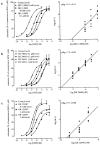Pharmacological characterization of 5-HT4 receptors mediating relaxation of canine isolated rectum circular smooth muscle
- PMID: 10455293
- PMCID: PMC1760667
- DOI: 10.1038/sj.bjp.0702665
Pharmacological characterization of 5-HT4 receptors mediating relaxation of canine isolated rectum circular smooth muscle
Abstract
This study aimed to characterize for the first time in vitro 5-HT4 receptors in the canine gastrointestinal tract. For this purpose, we used circular muscle strips of the canine isolated rectum. In the presence of methysergide (60 microM), 5-HT induced relaxation of methacholine (1 microM)-precontracted muscle strips, yielding a monophasic sigmoidal concentration-relaxation curve (pEC50 7.2+/-0.07). Tetrodotoxin (0.3 microM) did not affect the curve to 5-HT, suggesting the inhibitory 5-HT receptor is located on the smooth muscle. Granisetron (0.3 microM) did also not affect the curve to 5-HT, which excludes the 5-HT3 receptor mediating the relaxation to 5-HT. The presence of methysergide rules out the involvement of 5-HT1, 5-HT2 or 5-HT7 receptors. 5-HT, the selective 5-HT4 receptor agonists R076186, prucalopride (R093877) and SDZ HTF-919 and the 5-HT4 receptor agonists cisapride and 5-MeOT relaxed the muscle strips with a rank order of potency R076186 = 5-HT > cisapride > prucalopride > or = SDZ HTF-919 > 5-MeOT. The selective 5-HT4 receptor antagonists GR 125487, RS 39604 and GR 113808 competitively antagonized the relaxations to 5-HT, yielding pK(B) estimates of 9.7, 7.9 and 9.1, respectively. The selective 5-HT4 receptor antagonist SB 204070 shifted the curve to 5-HT rightward and depressed the maximal response (apparent pA2 10.6). GR 113808 (10 nM) produced a parallel rightward shift of the curve to the selective 5-HT4 receptor agonists R076186 (pA2 8.8). It is concluded that 5-HT induces relaxation of the canine rectum circular muscle through stimulation of a single population of smooth muscle 5-HT4 receptors. For the first time, a nonhuman species was shown to exhibit relaxant 5-HT4 receptors in the large intestine.
Figures




Similar articles
-
Characterization of the contraction to 5-HT in the canine colon longitudinal muscle.Br J Pharmacol. 1997 Feb;120(4):714-20. doi: 10.1038/sj.bjp.0700954. Br J Pharmacol. 1997. PMID: 9051313 Free PMC article.
-
An improved in vitro bioassay for the study of 5-HT(4) receptors in the human isolated large intestinal circular muscle.Br J Pharmacol. 2000 Apr;129(8):1601-8. doi: 10.1038/sj.bjp.0703254. Br J Pharmacol. 2000. PMID: 10780964 Free PMC article.
-
5-HT(4) receptors mediating enhancement of contractility in canine stomach; an in vitro and in vivo study.Br J Pharmacol. 2001 Apr;132(8):1941-7. doi: 10.1038/sj.bjp.0703985. Br J Pharmacol. 2001. PMID: 11309267 Free PMC article.
-
Irritable bowel syndrome: new agents targeting serotonin receptor subtypes.Drugs. 2001;61(3):317-32. doi: 10.2165/00003495-200161030-00001. Drugs. 2001. PMID: 11293643 Review.
-
Serotonin 5-HT3, 5-HT4, and 5-HT-M receptors.Neuropsychopharmacology. 1990 Oct-Dec;3(5-6):371-83. Neuropsychopharmacology. 1990. PMID: 2078273 Review.
Cited by
-
5-HT(4) receptors on cholinergic nerves involved in contractility of canine and human large intestine longitudinal muscle.Br J Pharmacol. 2000 Nov;131(5):927-32. doi: 10.1038/sj.bjp.0703615. Br J Pharmacol. 2000. PMID: 11053213 Free PMC article.
-
Intraoperative serosal extracellular mapping of the human distal colon: a feasibility study.Biomed Eng Online. 2021 Oct 16;20(1):105. doi: 10.1186/s12938-021-00944-x. Biomed Eng Online. 2021. PMID: 34656127 Free PMC article.
-
An update on prucalopride in the treatment of chronic constipation.Therap Adv Gastroenterol. 2017 Nov;10(11):877-887. doi: 10.1177/1756283X17734809. Epub 2017 Oct 16. Therap Adv Gastroenterol. 2017. PMID: 29147138 Free PMC article. Review.
-
Prucalopride.Drugs. 2009;69(17):2463-76. doi: 10.2165/11204000-000000000-00000. Drugs. 2009. PMID: 19911858 Clinical Trial.
-
5-HT decreases contractile and electrical activities in lymphatic vessels of the guinea-pig mesentery: role of 5-HT 7-receptors.Br J Pharmacol. 2003 May;139(2):243-54. doi: 10.1038/sj.bjp.0705264. Br J Pharmacol. 2003. PMID: 12770929 Free PMC article.
References
-
- BAXTER G.S., CRAIG D.A., CLARKE D.E. 5-Hydroxytryptamine4 receptors mediate relaxation of the rat oesophageal tunica muscularis mucosae. Naunyn-Schmiedebergs' Arch. Pharmacol. 1991;343:439–446. - PubMed
-
- BINGHAM S., KING B.F., RUSHANT B., SMITH M.I., GASTER L., SANGER G.J. Antagonism by SB 204070 of 5-HT-evoked contractions in the dog stomach: an in-vivo model of 5-HT4 receptor function. J. Pharm. Pharmacol. 1995;47:219–222. - PubMed
-
- BLONDEL O., GASTINEAU M., DAHMOUNE Y., LANGLOIS M., FISCHMEISTER R. Cloning, expression, and pharmacology of four human 5-hydroxytryptamine4 receptor isoforms produced by alternative splicing in the carboxyl terminus. J. Neurochem. 1998;70:2252–2261. - PubMed
Publication types
MeSH terms
Substances
LinkOut - more resources
Full Text Sources
Other Literature Sources
Miscellaneous

